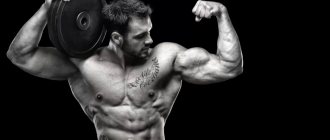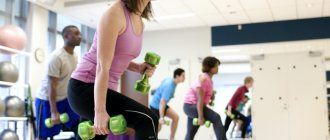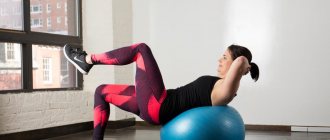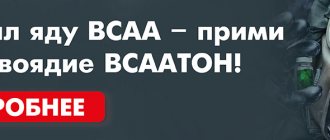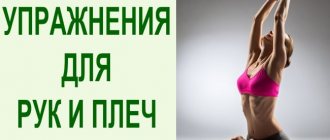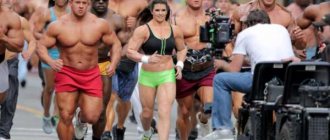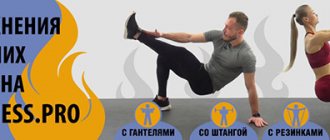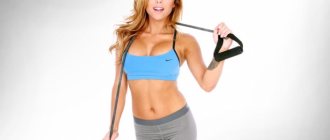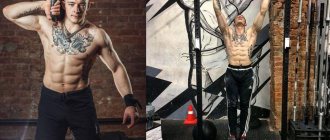- Training frequency.
Sports and walks in the fresh air are the basis of a fulfilling life, as well as an always toned body that causes admiration. Being active is good for your health. But what if work or other commitments do not allow you to lead such a lifestyle? Regular training is an opportunity to maintain a normal physical and psychological state.
Let's understand the features and principles of the programs. This will allow beginners to avoid serious mistakes at the beginning of their sports life, and experienced athletes to work more efficiently, getting better results every time.
The essence of functional training
The priority is not in pumping up some muscles and aesthetics of the body. It is to ensure healthy mobility and prevent injuries in sports and everyday life. Therefore, a beginner will perform light kettlebell rows from the floor in order to calmly put bags of groceries in the trunk. The football player is a deadlifter with decent weights on the bar, because his goal is to develop maximum power when he runs after the ball. Sprinter - jumping with a barbell. A young lady who is always losing weight with about 10 years of training experience and symptoms of fatigue on her face - some exotic lunges to the side with a twist of the body.
This is a universal methodological technique, which consists of the following:
- To develop healthy joint mobility and mobility in general, squats, rows from the floor, pull-ups or their imitation, presses in all planes and step-ups are given.
- Endurance is formed by the same exercises, but in the “30-50 seconds under load, one minute rest” mode.
- Strength - again the same universal set, but in the range of 3-6 repetitions in 3-7 approaches, with rest until recovery and significant weights on the bar.
- Coordination for team sports - complicated movements, for example, thrusters, that is, a hybrid of a front squat and an up press, and various lunges on unstable platforms like bosu.
- Tactical qualities for special services, army and police - strength training in a low-repetition mode in combination with the so-called “metabolic”, or interval, for strength endurance. This allows a soldier to run through the desert with a wounded comrade on his shoulders and periodically shoot back from the enemy, and a policeman to catch up with any bandit in 10 seconds.
Why then do women in group classes do barefoot lunges and simultaneous biceps curls? It is unlikely that this is preparatory functional training for surfing. This is how the instructor entertains them, distracts them from the monotony and loads them with physical activity. From this point the drama begins. Strength fitness professionals reject group functional training as traumatic and useless. YouTube stars promote it because in 20 minutes a day you can get so worked up that you have the complete illusion that you are training intensively. The hosts of weight loss marathons also promote it, and even as an alternative to strength training for health.
© ty — stock.adobe.com
Other directions
Other areas include those fitness centers where training is carried out in a sports-game mode. In these gyms you can:
- Play basketball
- Football
- Squash
- Tennis
And many other popular group games.
This is done so that a person who wants to acquire a new body shape can achieve this at an accelerated pace. For example, when doing ordinary training, a person may not only get bored, but he may also get tired of the variety, and the sports-game mode of training allows you to escape from problems and achieve the desired result while playing.
Benefit
Globally, functional fitness has brought people back to physical activity. He convinced the masses that half an hour of regular exercise a day and doing circuit training is enough to look decent, have strong muscles, low fat percentage, good mobility and avoid back pain from sedentary work.
Pros for the average person:
- Saves time. The workouts are organized on a circular or interval basis, do not require much rest between approaches and allow you to work out all muscle groups in 30-40 minutes.
- Increases metabolic response. After such a workout, the body consumes oxygen more actively and spends more energy. It's easier to lose weight if you follow a rational diet.
- Works all muscle groups. No need to worry about biceps, brachialis and gluteus medius.
- Helps you do less cardio. Typical functional training trains the heart too. Long hours on the track are not additionally needed. Just add 30 minutes of WHO recommended walking a day to produce vitamin D.
Pros for the athlete:
- Prevention of injuries.
- Improved performance in the main sport.
- Supports favorable body composition.
- Psychological relief.
© puhhha — stock.adobe.com
For gaining muscle mass
This type of strength training has one main goal - muscle hypertrophy. Muscle volume is determined by the number of muscle fibers, cross-sectional area and the volume of intercellular space. To increase muscle mass, we need to increase the number of these indicators, primarily muscle fibers. This is why this type of strength training is needed.
Due to the fact that anaerobic training, as we have already said, upsets the balance between consumption and restoration of ATP, microtrauma occurs (damage to myofibril filaments), and it is these microtraumas that respond in the form of muscle pain the next day or every other day. Microtrauma causes an increase in cross-sectional area. Thus, after restoration with the same type of load, microtrauma will no longer occur, since the load will already affect a larger area. This is muscle hypertrophy - a natural adaptive reaction of the body to the stress experienced.
It is immediately worth noting that the concept of microtrauma does not mean damage to the muscle - only a violation of the integrity of the internal structure of the fiber occurs, and not the fiber itself.
Thus, this type of strength training is aimed at gradually increasing the strength load, which would lead to stress and microtrauma, thereby causing hypertrophy. But, alas, if everything were that simple, there would be no questions related to the nutritional habits of bodybuilders and the use of anabolic drugs. The process of constant muscle hypertrophy in conditions of constant adaptation and a genetically specified physiological “ceiling” does not allow a person to grow indefinitely. But that is another story.
Types of functional training
There are two big types:
- Group fitness classes.
- Training according to an individual program to develop certain qualities.
The first are implemented within the framework of the Functional, Athletic Body, NTC, Body Rock and other similar programs. The key is a constantly changing set of movements based on squats, lunges, push-ups, burpees, standing dumbbell presses and various rows. The group performs counting exercises, usually spending a minute under tension and quickly moving from one exercise to the next. Between cycles – rest 1-2 minutes. Physiologically this is aerobics. But marketers tell us that it replaces power. Yes, if we are talking about the typical request “somehow to lose weight for the beach.” And no, if you need a serious correction of the client’s posture, elimination of muscle imbalances, the consequences of prolonged physical inactivity, or a banal “pumping up” of the buttocks, shoulders, biceps and everything that people usually want to see as outstanding.
Functional training for bloggers can also be included in this large class. Example – Zuzana Light, Sugary Six Pack, Katya Buida, project “Mad Drying” and others. They are united by catchy video names and typical content:
- a lot of burpees and jumping jacks between exercises;
- more jumping out of squats and lunges;
- micro dumbbells for the arms, with which they perform some kind of biceps curls during squats;
- mandatory planks and crunches;
- Push-ups are also a must.
Such programs are good for a person without problems with musculoskeletal muscles and a lot of excess weight, but with experience in performing the same squats, push-ups and lunges. A large volume will help tone muscles and increase calorie consumption, your figure will improve, and fat deposits will disappear (of course, subject to a proper diet).
Within group programs, CrossFit is highlighted. If we are not talking about performing athletes, then this is a high-intensity program that combines real strength and weightlifting exercises with aerobic work in a high heart rate zone. It allows you to develop “everything” if you approach the technique correctly and set it up. Or it will be a simple way to burn calories for someone who makes movements at half the amplitude and “as best he can.”
Custom functional programs are written upon request and can include a wide variety of elements.
© Nebojsa — stock.adobe.com
Shaping - jumping and swinging to upbeat music
One of the brightest types of cardio fitness is shaping. Body correction is achieved through active exercises, which are performed to rhythmic music, which helps athletes maintain a high tempo.
Shaping originated in 1988 - immediately as a system of exercises designed to correct the female figure. Nine female body types have been identified, and for each, ideal proportions have been developed to strive for.
For women with a certain body type, it is necessary to use a specific exercise program.
It is recommended to perform the elements at an average pace and alternate exercises intended for different muscle groups. With the help of shaping, you can achieve two goals at once: lose weight and strengthen your muscles, making them more prominent.
In recent years, this sports practice has begun to develop. Varieties of programs designed for men have appeared.
All classes are performed accompanied by rhythmic music. Aerobics is built on a set of exercises that stimulate an increase in the rhythm of breathing and the work of the heart muscle.
This includes the following types of physical activity:
- run;
- walking at a fast pace;
- various jumps, etc.
Features of weight loss training
D. Smirnov, mentioned at the beginning of the article, believes that training for weight loss exists. And this is something like a circuit with fairly serious weights and multi-joint basic exercises. Cardio – interval. Diet – with a calorie deficit. All other methodologists believe that such exercises serve to increase strength endurance in sports, and a simple gym goer does not need all this.
In practice, functional training is used to “speed up metabolism.” This is a real task if a person has decent joint mobility, good technique, he is ready not to “destroy” weights as soon as he goes on a calorie deficit, and is able to recover.
CrossFit recommends that those losing weight get rid of sweets and build a diet based on cereals, meat, eggs, nuts, vegetables and herbs.
Most beginners should do some sort of circuit training of exercises with no (or minimal) weights and try to build up range and tempo. And, of course, do not forget about the calorie deficit, without which any workout will not be effective.
Do you need all sorts of barefoot lunges and other exotic versions of movements with medicine balls to lose weight? Actually, no. This is the main complaint of all sensible humanity about functional club fitness. The average person will take too long to figure out how to repeat the exercise in order to do it beautifully and effectively. It is better to make the work technically simpler, but not to interrupt it to look again at what the instructor is showing there.
https://youtu.be/eYJ5Kw53lvc
Endurance
This type of strength training is aimed at increasing physical strength endurance (not the endurance that is achieved during marathon running). Also, in the article about anaerobic training, we already said that with constant energy expenditure, the body adapts and begins to accumulate more creatine phosphate and glycogen, allowing it to work much longer. This is what underlies the development of strength endurance. But some types, or rather the majority of them, require a combination of aerobic and anaerobic endurance, i.e., for example, wrestlers, boxers, sprinters are forced to work under both anaerobic and aerobic conditions.
Contraindications for exercise
Ironically, there are almost none. Even a person with musculoskeletal injuries, high blood pressure and excess weight can engage in such fitness. Only he will do 10 shallow squats with rest and push-ups against the wall. The beauty of the system is that it can be adapted to almost any level of training.
However, you should avoid training if:
- there are contraindications to cardio load from the heart and blood vessels;
- there is an active injury;
- a person is suffering from ARVI;
- a chronic disease has worsened;
- Before us is a newcomer with a serious violation of posture or curvature of the spine;
- joint mobility is limited.
In sports
Ideomotor training, as a method of self-regulation, is used in preparation for sports competitions. The athlete imagines his movements mentally from the outside, which gives him the opportunity to better master the exercise.
In sports, many criticize this approach, calling it useless. But those who have trained for a long time and learned to control their muscles consider the method effective and necessary.
Some people find it easier to imagine a fixed image, while others find it easier to imagine a whole movement. But it is important to always notice your sensations and control the work of your muscles. Developing the skill of mentally imagining movements allows you to quickly reproduce the exercise in reality.
Athletes, gymnasts, and acrobats especially need such training, because it is important for them to be aware of the position of the body in space.
Stages
The ideomotor method can be mastered by anyone, and the learning takes place in several stages.
The stages of mastering ideomotor training include:
- Elementary. A person must begin by learning to clearly imagine his goal - a specific movement. Therefore, before starting a workout, you need to perform the exercise several times - this way the brain will remember the sequence of actions and sensations.
- Training. At this stage, a person verbally formalizes his movements in a real exercise, and then transfers the training into a mental representation. At the moment of verbal description of movements, they are spoken out at the moment when the movement directly occurs. The person describes what needs to be done and his feelings at the moment.
- Automation. The most difficult thing in training is the reproduction of muscle-articular tendon sensations. First, a person conducts real training, then learns to create tension in the muscles, then in the joints. Only after this sensations can be reproduced by consciousness.
